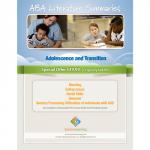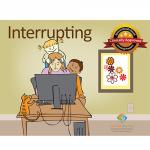Blog Categories
- ADHD
- Applied Behavior Analysis
- Autism Awareness
- Autism Service Providers
- Case Studies
- Dignosis
- Classroom Management
- Credentials
- Ethics
- Family Matters
- FAQs About LIVE Events
- Financial Planning
- Holiday Planning
- IEP's
- Panelists
- Private Equity in Autism & ABA Industry
- Psychopharmacology
- Sensory Processing Disorder
- Speech and Communication
- Subject Matter Experts
- Summer Planning
- Transition Planning
Siblings of Children with Autism: How to Meet Their Needs
in the field of social work. She has worked as a counselor in the Chemical Dependency field, a CPST worker with children/adolescents, a Functional Family Therapist (FFT) with adolescents and their families, a Psychotherapist with dually diagnosed adults and currently works as an LISW who provides case management services for parents of children with Autism.
Leslie graduated from the University of Cincinnati in Ohio with a Master’s in Social Work in June 2006 after completing a 1 year accelerated graduate program. She obtained her Bachelors Degree in Social Work from the University of Cincinnati in June 2005. She obtained her supervision designation in October 2010.
Siblings of Children with Autism: How to Meet Their Needs
Many families of children with Autism will say that the majority of their attention and time is focused on their child with special needs. It isn’t that these families aren’t sensitive to the needs of their other children; however, they are often dominated by the pressing concerns and needs of their child with Autism. Often parents feel torn into portions with very little left to share among all their children. The siblings in a household with a child with Autism often display their own signs of emotional distress, mental health needs and behavioral difficulties. These behaviors may stem from mimicking the behaviors of their sibling with special needs as an attention seeking mechanism. The emotional and mental health concerns often stem from many, sometimes unavoidable, factors such as anger, jealousy, lack of own emotional needs being met and possible post-traumatic stress symptoms. Parents typically find themselves frustrated, overwhelmed and at a loss as to how to manage or help the other children or child in the home.
One of the most reported symptoms or expression of need that parents report to me is that their other child is “acting out” or exhibiting some aggression towards him or herself, sometimes even towards the sibling with Autism. Often parents show little/no patience for their typical child when it comes to their “acting out” behaviors or any impatience that child might show toward their sibling with special needs. The following are condensed insights on how to recognize and meet the needs of typical siblings in the home with a child with Autism.
Symptom/Behaviors
Anger
o Anger usually presents itself as aggression such as hitting, pinching, kicking…etc. Aggression may be directed outward to others/animals or inward at self. Anger, however, may be more covert such as stealing, lying, manipulating, creating chaos and/or being oppositional. The sibling of a child with Autism may feel angry for several reasons. He/she may be angry or disappointed because he/she doesn’t have a typical sibling to play with and/or he/she may feel embarrassed of his/her sibling’s behaviors. A child in the home where there is a sibling with Autism may resent the instability in the home, the barrage of care providers in and out, the stress his/her parents always seem to be under and how his/her life always seem to shift around his/her sibling. Often a sibling may not have the opportunity to express his/her feelings, sometimes because the parent(s) are not able to express theirs. Many times a sibling is expected to have the emotional fortitude of a well-rounded, emotionally healthy adult and simply understand and accept the behaviors he/she witnesses or endures as well as all the effects of his/her sibling’s diagnosis on his/her life.
Intervention:
Allow your child time to openly and honestly talk about his/her feelings. Be sure to validate your child’s feelings as much as possible without condoning inappropriate behaviors. Your child needs to feel heard. It’s okay to tell your child that you’re sorry that he/she feels the way he/she does. He/she needs to talk about what he/she wants or wishes. He/she needs to feel protected from aggressive behaviors as much as possible and must be allowed to have some things that are just for him/her which aren’t altered or sacrificed.
Jealousy
o Jealousy can occur with any siblings, but the sibling of a child with special needs may struggle with this emotion even more so. The root of this emotion is often insecurity. If a child does not know or understand his/her place in the home or the heart of his/her parents, insecurity and low self-esteem may develop. Sometimes, a sibling, as well as the parents’ needs and identities will just blend into the background and the endless therapies, providers and/or crisis. The other children in the home may be set safely off to the side and assumed “okay” and gratefully so. However, the children may receive the message that they aren’t as special or that their needs do not matter.
Intervention:
Parents need to be aware and careful of the messages they are sending to the other children in the home, especially when the focus and household seems to circle the needs of the child with Autism. It is important that a sibling has something that makes him/her special to him/herself and to the parent(s). He/she needs to be recognized with just as much energy as is given to the child with Autism. Make a date to spend quality time with the sibling at least once a week, separately and focus that entire time on that child.
Attention Seeking
o Attention seeking behaviors can be a subset of jealous feelings, yet envy may not necessarily be attached. However, insecurity and mistrust may have a great deal to do with this behavior in a typical child. One of the key stages of human development is individual is given the opportunity to learn to trust that his/her needs will be met. Though the basic physical needs are often met, the basic emotional needs may not be. The child may not perceive him or herself as loved or even as visible in the household. This may be determined by what the child has learned to base love on; for example, the child may not feel loved if he connects love with the time the parent spins with him or the attention given to his sibling. The child’s attempts at obtaining attention may be associated with the fear that he/she will not be loved if he/she doesn’t earn it or bully for it. His/her attention seeking behaviors may be acts of desperation and may be a warning sign that there is a hole or a need within the child that is not being filled.
Intervention:
Again, parents will need to be as in tune with the other children in the home as they are with the sibling with special needs. A parent cannot assume that their child is managing or adapting and well adjusted. Parents may need to help their child recognize special things about him/herself as the child might have learned to ignore him/herself. Parents may need to be sensitive to their child’s need for time or attention, as minimal as it might seem. It might be as simple as noticing something new or making a big deal over a small accomplishment. These children need to feel seen and visible. Do not accidently reinforce attention seeking behaviors by isolating attention to times when the child has “earned” it by performing a certain way or when he/she has demanded it through negative behaviors. You do not want to send the message that the child has to be a certain way, whether good or bad, to deserve your attention.
Depression
o Siblings may show symptoms of depression without being actually clinically depressed. Siblings may develop a feeling of helplessness, especially if their siblings with Autism are aggressive towards them or other family members or if the home is in constant crisis. They may feel isolated from peers or because their parents are isolated. Some depressive behaviors can be learned as means of dealing with the world or negative expectations. Parents can pass these learned outlooks to their children. Additionally, as the child grows up with feelings of unexpressed anger and insecurity with no sense of self importance, depressive symptoms may be a natural progression. Children may feel displaced in a home where they feel invisible and possibly unable to relate to their peers at school or in the community.
Intervention:
First, it is important to try to identify and address a child’s needs as early as possible; however, if the child does start to show signs of prolonged sadness, hopelessness, devalued sense of self and disturbs in mood or any signs of depression seek professional intervention as soon as possible. If you haven’t had a smooth line of communication with the child until now, it is never too late to start. Remember, the child did not come to this place magically or overnight. Acknowledge the experiences that contributed to your child’s distress and learn how to be his/her advocate as well. A parent may also have to look at how they handle stress and their emotions. The first intervention may require the parent learning how to navigate and express his/her feelings as well as developing health ways of coping with life.
Parentification
o A sibling of a child with Autism may have unfair expectations placed on him/her that is well beyond his/her years and/or comprehension. Often parents will lean on the typical child, even if he/she is younger or not much older, for support. They may misread the typical child as being emotionally ready and aware of his/her siblings needs and able to handle his/her sibling’s behaviors. These children are sometimes expected to always be sensitive, patient, understanding, nurturing and observant despite having to live with aggression, lack of personal space or having to give into the demands of a sibling who is having tantrum. These children are sometimes asked to care take for their siblings and sometimes their parents. These children appear older than their years and are often wracked with worry, stress and experience feelings of displacement from their peers.
Intervention:
It is imperative that siblings are allowed to be children and only expected to act as children. They need to have friends and be allowed to participate in activities outside of the home. Allow them to have typical reactions to atypical situations and guide them through any feelings or behaviors that are inappropriate. Help them replace those inappropriate reactions with appropriate, healthy ones, but do not devalue, discredit or make them deny their feelings. It is a parent’s role to guide the child through these difficult emotions and not simply expect them to fall in line and know their role. However, the parent must be at a healthy place emotionally to have the strength and wherewithal to be guidance counselor, referee and generally be able to recognize and meet the needs of a household.
Anxiety
o Anxiety is usually a culmination of the insecurity, instability, ever-changing, strained environment and strained emotions that have gone unnoticed or undisclosed. Often, there is a sense of fear, uncertainty and a feeling of the person being or life being out of control. The known is frightening and the unknown is terrifying. Whether there has been a constant change of schools, homes or an environment where there were extremes from one moment to another, children in these household can develop anxiety. This anxiety may be related to their surroundings and their abilities to keep themselves safe. Moreover, anxiety can be related to their desires to have something be controllable and predictable in their lives. Anxiety may show up as excessive worry and catastrophizing over unpredictable events. The child may develop obsessive and compulsive behaviors or irrational fears.
Intervention:
Recognize that anxiety symptoms may signal a biological disorder or they may be your child’s way of trying to feel safe in a world he/she deems as unsafe and unstable. As mentioned earlier, make every attempt to protect your child from aggressive behaviors or excessive shifts in the environment. In a perfect world, this would be easy, but it isn’t always possible. When your child has been aggressed towards, make every attempt to get him/her to a safe place as soon as possible and emotionally and physically make sure he/she knows he/she is safe and you are there. Again, validate his/her feelings and try to give him/her time away from the home, possibly allow him to visit the grandparents or friends often. Allow a professional determine if his symptoms are biological or learned responses to stress. If they are learned, your child will need to learn to trust himself, you and his environment as this is something he/she may not have developed at a younger age. The interventions will be based on your child’s age, cognitive abilities, comprehension and degree of symptomology.
Of course, there are several other behaviors, needs and symptoms children may present. It is important to see these responses as possibly normal initial reactions with possible harmful outcomes if allowed to fester without interventions. It is important to view each child as separate individual with separate needs. Siblings need to have a forum to express their feelings and learn ways to identify their needs and individual special qualities. There needs to be a life and interests as well as semblances of stability and consistency outside of the home. Parents need to do their best to take care of themselves emotionally and mentally in order to model healthy ways of handling stress and dealing with emotions. Find ways to create stability and consistency in the home as much as possible even if it’s just consistent parent/child time each week. Do not ignore behavioral concerns, but also do not treat behaviors with impatience. Some behaviors and ways of thinking may need to be unlearned and replaced with healthy ways of handling stress and frustrations. However, some behaviors and moods may signal biological issues that may need to be evaluated by a Psychologist, Clinical Social Worker and/or Psychiatrist. Do not take any need or behavior for granted and advocate for the wellness of all family members, including your own.
RECOMMENDED PRODUCTS
Adolescence and Transition Bundle
Interrupting Social Story Curriculum




